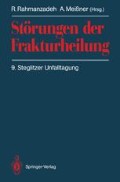Zusammenfassung
Die Häufigkeit einer posttraumatischen Osteomyelitis nach offenen Frakturen wird mit 10–25% angegeben [13] und steht v.a. im Zusammenhang mit der lokalen Durchblutungsstörung des Knochens und der Weichteile [2, 10, 15, 16]. Im avitalen und minderperfundierten Gewebe können die Abwehrvorgänge des Organismus nicht in gewohnter Weise vonstatten gehen, und zudem stellen diese Gewebeanteile eine optimale Voraussetzung für die Vermehrung von Mikroorganismen dar.
Access this chapter
Tax calculation will be finalised at checkout
Purchases are for personal use only
Preview
Unable to display preview. Download preview PDF.
Literatur
Ascherl R, Lechner F, Blümel G (1985) Electrical Stimulation of low frequency range in cases of pseudarthroses. Reconstr Surg Traumatol 19: 106–112
Burri L (1979) Posttraumatische Osteitis. Huber, Bern Stuttgart Wien
Caudle, RJ, Stern PJ (1987) Severe open fractures of the tibia. J Bone Joint Surg [Am] 69: 801–807
Chang N, Mathes St (1982) Comparison of the effect of bacterial inoculation in musculocutaneous and random-pattern flaps. Plast Reconstr Surg 70: 1–6
Eitel F, Schweiberer L, Klapp F, Darnbe LT (1982) Störungen der Mikrozirkulation in Frakturzonen als Basis der Knocheninfektion. H Unfallheilkd 157: 20–32
Fisher J, Wood M (1984) Quantitation of bone revascularisation by musculocutaneous and cutaneous flaps using a methyl-methacrylate bone cookie. Plast Res Council of the A.S.P.R.S., Detroit
Fitzgerald, RH, Ruttie PE, Arnold PG, Kelly PJ, Irons GB (1985) Local muscle flaps in the treatment of chronic osteomyelitis. J Bone Joint Surg [Am] 67: 175–185
Gordon L, Chin EJ (1988) Treatment of infected non-unions and segmental defects of the tibia with staged microvascular muscle transplantation and bone grafting. J Bone Joint Surg [Am] 70: 377–386
Gottrup F, Fimin R, Hunt TK, Mathes SJ (1984) The dynamic properties of tissue oxygen in healing flaps. Surgery 95: 527–536
Gustillo RB, Mendoza RM, Williams DN (1984) Problems in the management of type III (severe) open fractures: a new classification of type III open fractures. J Trauma 24: 742–746
Habermeyer P, Kaiser E, Mandekow H, Schweiberer L, Stock W (1987) Anatomie und Klinik der Sartoriusplastik. Handchir Mikrochir Plast Chir 19: 21–22
Heckler FR (1980) Graciles myocutaneous and muscle flaps. Clin Plast Surg 7: 27–44
Henley MB (1989) Intramedullary devices for tibial fracture stabilization. Clin Orthop 240: 88–96
Hierholzer S, Hierholzer G (1985) Unspezifische und spezifische Infektabwehrmechanismen bei der chronischen posttraumatischen Knocheninfektion. Unfallchirurg 88: 255–262
Hildebrandt G, Höhne C (1982) Sogenannte apathogene Erreger und avitale Diaphysenkortikalis in der Genese der Osteomyelitis posttraumatica. Beitr Orthop Traumatol 29: 34–43
Hörster G (1986) Ätiologie und Pathophysiologic der posttraumatischen Knocheninfektion. Unfallchirurgie 12: 93–97
Hohn DC, McKay RD, Malliclay B, Hunt TK (1976) Effect of 02 tension on microbicidal function of leukocytes in wounds and in vitro. Surg Forum 27: 18–26
Janecka IP (1980) Lower extremity reconstruction using myocutaneous flaps. Orthopaedics 3: 1097–1101
Irons GB, Fisher J, Schmitt EH (1984) Vascularized muscular and musculocutaneous flaps for management of osteomyelitis. Orthop Clin North Am 15: 473–480
Kelly PJ (1977) Infection of bone and joint in adult patients. Mosby, St. Louis (Instructional course lectures, AAOS, vol 26, pp 3–13 )
Ketterl R, Stübinger B, Steinau HU, Claudi B (1987) Behandlungskonzept bei infizierten Pseudarthrosen des Unterschenkels. H Unfallheilkd 189: 586–596
Ketterl R, Jessberger J, Machka K, Geißdörfer K, Stübinger B, Blümel G (1988) Effektivität des pulsierenden Wasserstrahls ( Jet Lavage) zur Reinigung infizierter Wunden. Langenbecks Arch Chir [Suppl]II: 690–691
Magee WP, Gilbert DA, Melnnis WD (1980) Extended muscle and myocutaneous flaps. Clin Plast Surg 7: 57–70
Mathes SJ, Alpert BS, Chang N (1982) Use of muscle flaps in chronic osteomyelitis: Experimental and clinical correlation. Plast Reconstr Surg 69: 815–828
May JR, Gallico GG, Jupiter J, Savage RC (1984) Free latissimus dorsi muscle flap with skin graft for treatment of traumatic chronic bony wounds. Plast Reconstr Surg 73: 641–651
Moore JR, Weiland AJ (1986) Vascularized tissue transfer in the treatment of steomyelitis. Clin Plast Surg 13: 657–662
Rahn BA, Perren SM (1971) Xylenol orange, a flourochrome useful in polychrome sequential labelling of calcifying tissue. Stain Technol 46: 125–129
Rahn BA, Perren SM (1975) Die mehrfarbige Fluoreszenzmarkierung des Knochenanbaues. Chem Rundschau 28: 12–85
Rhinelaender FW, Baragry RA (1962) Microangiography in bone healing. J Bone Joint Surg [Am] 44: 1273–1298
Ryan BG (1974) Mediators of inflammation. Beitr Pathol 152: 272–278
Suzuki HR, Mathews A (1960) Two-color fluorescent labelling of mineralizing tissue with tetracycline and fluorescan. Stain Technol 41: 57–60
Tscherne H (1984) The management of open fractures. In: Tscherne H, Götzen L (eds) Fractures with soft tissue injuries. Springer, Berlin Heidelberg New York Tokyo, pp 10– 32
Verwey WF, Williams HR, Kalsow C (1965) Penetration of chemotherapy agents into tissues. Antimicrob Agents Chemother 1: 1016–1024
Author information
Authors and Affiliations
Editor information
Editors and Affiliations
Rights and permissions
Copyright information
© 1992 Springer-Verlag Berlin Heidelberg
About this paper
Cite this paper
Ketterl, R., Ascherl, R., Steinau, H.U., Claudi, B. (1992). Muskellappen bei infiziertem Knochen. In: Rahmanzadeh, R., Meißner, A. (eds) Störungen der Frakturheilung. Springer, Berlin, Heidelberg. https://doi.org/10.1007/978-3-642-76699-2_18
Download citation
DOI: https://doi.org/10.1007/978-3-642-76699-2_18
Publisher Name: Springer, Berlin, Heidelberg
Print ISBN: 978-3-540-54146-2
Online ISBN: 978-3-642-76699-2
eBook Packages: Springer Book Archive

